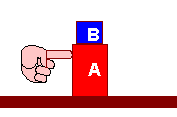
Teaching Physics with the Physics Suite
Home | Action Research Kit| Sample Problems | Resources | Product Information
Problems Sorted by Type | Problems Sorted by Subject | Problems Sorted by Chapter in UP
 |
Teaching Physics with the Physics Suite
Home | Action Research Kit| Sample Problems | Resources | Product Information |
Problems Sorted by Type | Problems Sorted by Subject | Problems Sorted by Chapter in UP |
| You are pushing on a large block that is resting on the table. On top of that block rest another, smaller block. You press on the block to start it moving. After about 0.25 s, it is moving at a constant speed and the block on the top is not slipping.
| 
|
Not finding what you wanted? Check the Site Map for more information.
Page last modified October 11, 2002: D18